IP traffic on AT&T‘s core network infrastructure already outnumbers traffic caused by plain old telephony system (POTS) by 8 to 1. This is the reason to invest another USD 3 billion in the coming years to convert the network to a complete Voice-Over-IP based network.
Archiv des Autors: Tim Pritlove
Project Censored
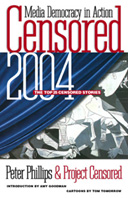 Project Censored is a group devoted to bring publicity to stories about „significant issues of which the public should be aware, but is not, for one reason or another“. Each year, they provide a list of the Top 25 censored stories.
Project Censored is a group devoted to bring publicity to stories about „significant issues of which the public should be aware, but is not, for one reason or another“. Each year, they provide a list of the Top 25 censored stories.
On October 4, 2003 they are going to present the Top 25 Censored Media Stories of 2002-2003. Ranking number one is „The Neoconservative Plan for Global Dominance„
More blinking buildings
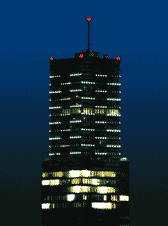 Light artist Heinz Mack seems to be behind a new Blinkenlights-style permanent light installation into the new KoelnTurm in Cologne. There is a movie clip available in three file formats, although the MPG seems to be corrupt (the QuickTime version is running).
Light artist Heinz Mack seems to be behind a new Blinkenlights-style permanent light installation into the new KoelnTurm in Cologne. There is a movie clip available in three file formats, although the MPG seems to be corrupt (the QuickTime version is running).
Looks nice, but there is no public interface available. It is however a decent and worthy enhancement to the structure.
Hello World, I Am Bitman
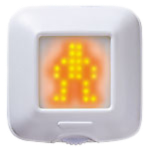 One of the weirdest artists at Ars Electronica Festival was Maywa Denki, a crazy japanese guy that creates all kinds of crazy objects (like a fishbone-shaped xylophone which lights a bulb for each key you hit with electric sticks), superweird automated and semi-automated musical instruments (like a pedal organ playing six guitars remotely) and all kinds of art objects, books, t-shirts and cool toys.
One of the weirdest artists at Ars Electronica Festival was Maywa Denki, a crazy japanese guy that creates all kinds of crazy objects (like a fishbone-shaped xylophone which lights a bulb for each key you hit with electric sticks), superweird automated and semi-automated musical instruments (like a pedal organ playing six guitars remotely) and all kinds of art objects, books, t-shirts and cool toys.
One of these toys is mine now as I couldn‘t resist buying one immediately. It is called Bitman and is a must for every Blinkenlights-inspired geek. The small device features a 8×8 pixel display with a couple of useful modes (displaying a scrolling text message or the current date). The default mode however displays Bitman, a small pixel person that just stands and looks at you.
Now the cool part: if you shake Bitman, the small pixel man jumps around, changes orientation and also produces some accompanying buzzing noises. This gravity sensor is also used to scroll through settings and to select characters for new messages. Simply beautiful trash art.
Maywa Denki also offers a big standalone light controller to control a 8×8 pixel display using light bulbs. Not sure what the actual interface is, the web site is neither very specific nor very link-friendly (fuck frames!)
Vienna: Aromat
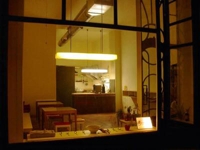 I am in Vienna now, enjoying the general friendlyness of the Austrian people. And the food and coffee culture, of course.
I am in Vienna now, enjoying the general friendlyness of the Austrian people. And the food and coffee culture, of course.
A good tip is a small restaurant called Aromat. Austrian food, very well done, very relaxed waiters. I still have problems reading Austrian menus as the words used for vegetables and other edible items tend to be quite different to the ones I am used to in northern Germany. But my Kalbsnierenbraten mit Bazknedeln was excellent.
Interesting to see that Aromat‘s nicely designed web site is actually running with weblog software from antville.org. Another good example where blogs are making publishing easy for a non-technical crowd.
English doubts on 9/11
Michael Meacher, member of the UK parliament and Minister of State for the Environment and Privy Counsellor from May 1997 to June 2003, comments on the topic of the day: This war on terrorism is bogus.
Building The Universal Translator
There is a neverending belief in technology out there in the outskirts of the Department Of Defense of the United States Of America. This time, they are pouring more money into development of a universal translator to bring wiretapping into the 21st (or 22nd) century. The new approach of the system developed by StreamSage is based on „statistical comparisons of parallel documents in different languages“. [via Quintessenz]
Ars Electronica: Tug Of War
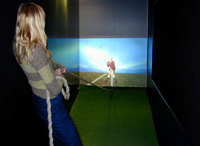 Another interesting development of Ars Electronica Center‘s own Futurelab is the Tug Of War installation simulating the real-life game of the same name. This is a very interactive installation as you are forced to pull the rope yourself against the computer.
Another interesting development of Ars Electronica Center‘s own Futurelab is the Tug Of War installation simulating the real-life game of the same name. This is a very interactive installation as you are forced to pull the rope yourself against the computer.
This would be easy if the electronics were not supported by a strong pneumatic machine that can pull the rope really strong. Actually, it is easy to cheat as you are calibrating the system to your personal strength by pulling once before the actual fight commences. The display shows a funny line up of ballett dancers and other weird personalities in equally weird environments. This is about fun and is accompanied by excellence of production. Well done.
Ars Electronica: Gulliver‘s Box
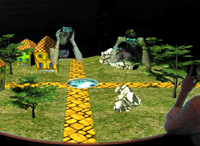 I still have to deliver a report on some other interesting installations at Ars Electronica. One of them is called Gulliver‘s Box.
I still have to deliver a report on some other interesting installations at Ars Electronica. One of them is called Gulliver‘s Box.
The setup consists of a round and empty table. The basic idea is that the table is a virtual space where you can put objects on. To view these objects and their virtual environment, you put on one of three 3D goggles. A computer tracks your viewpoint and you see the virtual scenery instead of the empty table.
In a shelf you find some transparent boxes. Behind the box is a display and you can see one of eight moving characters on them, supposedly living in the box. Here‘s the scoop: you take out the box, put in on the table, and you see the virtual character in the virtual scenery – in the box.
You can open the box (a lid moves) and the character jumps out, eventually interacting with other characters. Very nice shapes, nice movements, carefully designed. The resolution could be better, but I was told this was to leave room for including hi-res 3D scans of people that could be placed in the box instead. Unfortunately, this feature is not yet completed.
The system detects the state of the lid (open/closed) by use of firewire-coupled CCD cameras from above. An array of infrared LCDs provides the necessary lighting that can be reliably distinguished from other light sources. The lid has a certain symbol on top (closed) and underneath (open), so it is easy for the computer to track the state. The same system also tracks position and orientation of the box.
A projector produces a bright background light on the table from the center of the table to a mirror above and back on the table‘s surface. it is used to produce a real-world shadow of the virtual character. Really nice.
The whole system suffers a bit from the jittery behaviour of the 3D goggles (a software smoothener is needed) but basically everything has been done right. A cool project.
The FileMaker Problem
 Just bumped into a rumour on the next version of FileMaker, apparently called version 7. Reading something like „more updates than ever“ doesn‘t make my heart jump. As this company made no real progress for years, this might mean they are doing at least something, which is not the worst news.
Just bumped into a rumour on the next version of FileMaker, apparently called version 7. Reading something like „more updates than ever“ doesn‘t make my heart jump. As this company made no real progress for years, this might mean they are doing at least something, which is not the worst news.
Well, I don‘t want to be too harsh. The integration of XSLT in the version 6 release was an intelligent move. But FileMaker leaves so much to be desired that I do not expect them to be able to fix it soon. Let‘s have a look on the current state of FileMaker (I focus on the Mac OS X version as this is an Apple company and I don‘t care about Windows anyway)
Let me begin with the fact that I am a long-term user of FileMaker. I generally like the idea of an easy-to-use desktop database and FileMaker has some well though-out ideas that had to be invented if they wouldn‘t exist already. FileMaker is our tool for planning the conference tracks of the Congress and the Camp and I have used it in many other occasions as well. So why do I complain?
The user interface of FileMaker is old. It still has a System 6-like appearance and doesn‘t make use of so many Mac OS and Mac OS X technologies that are just more than obvious like the Keychain for example. Threading and multiprocessing seem to be non-existant as well and once your network connection goes away just for a microsecond (which can happen by removing your cable for a second or losing your wireless link) the program closes your remote databases immediately. Annoying.
My main problem is the lack of scriptability. The built-in scripting language is not very powerful and its syntax parser is an embarrassment. I use a mixed internationalization setup: while all the menus are english, I choose a european/german setting for date, time and numbers. FileMaker gets this confused and refuses certain script construct DEPENDING ON YOUR LOCALIZATION setting (sorry for the loud statement, but it had to be said).
Another drawback is the limited relation support. While you can establish relations between tables, following a path from within a script through two or more relations is simply not possible. Things like „give me the field X of record C which is referenced by a field in record B which is referenced by a field in record A“ (A->B->C->X) is not possible. To make things really absurd, FileMaker doesn‘t event support booleans!
So while a desktop database is still a good idea and FileMaker is a good choice for small solutions, it is very problematic for bigger and complex collections. The crumpy UI and the lack of an easy to access data from a shell or perl script is another drawback.
The funny thing is: there are so many good databases (like PostgresQL) that have all the robustness and flexibility you need, but nobody seems to think about creating a clean and and easy desktop interface for it. Microsoft has a lot of success with Access, the open source world has no answer to it. This has to change.
